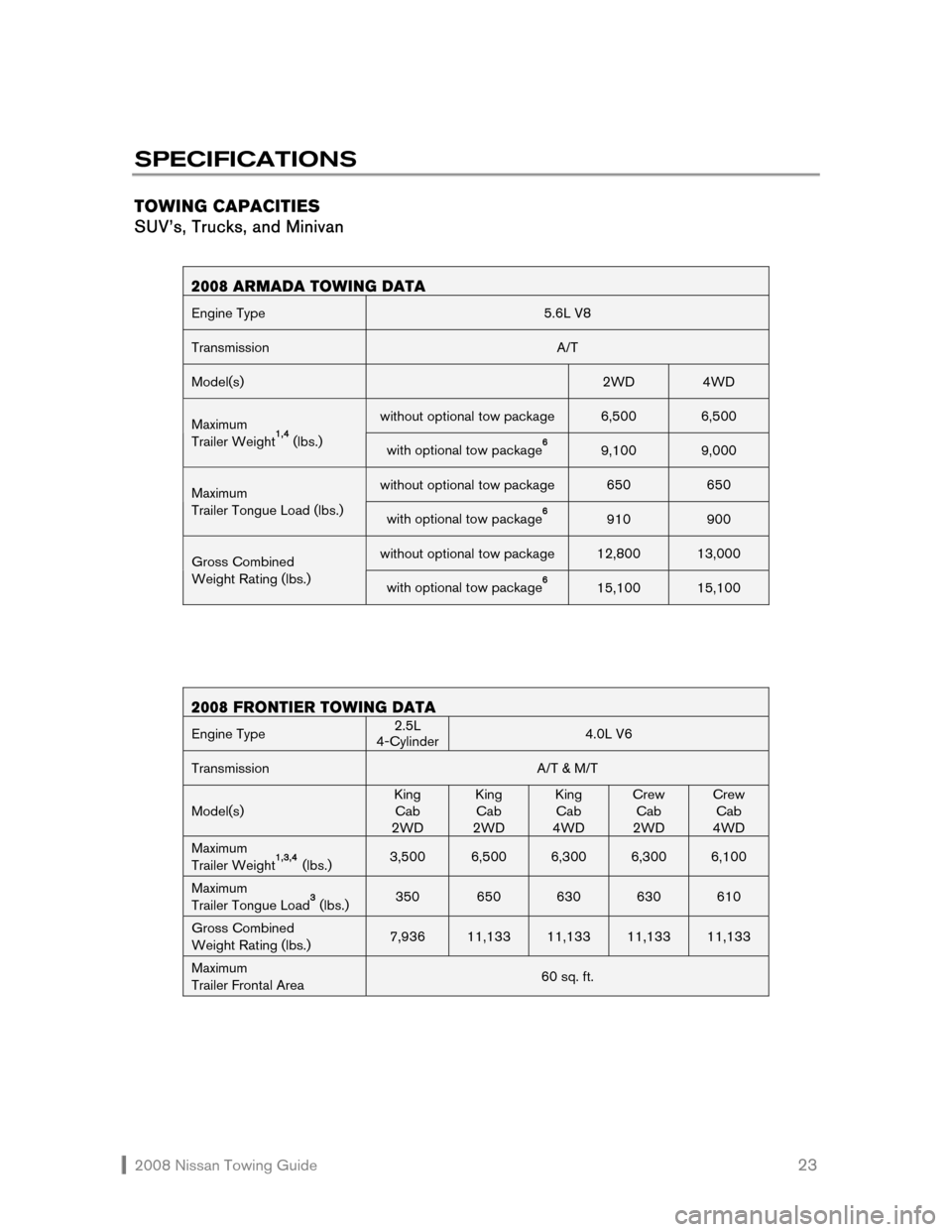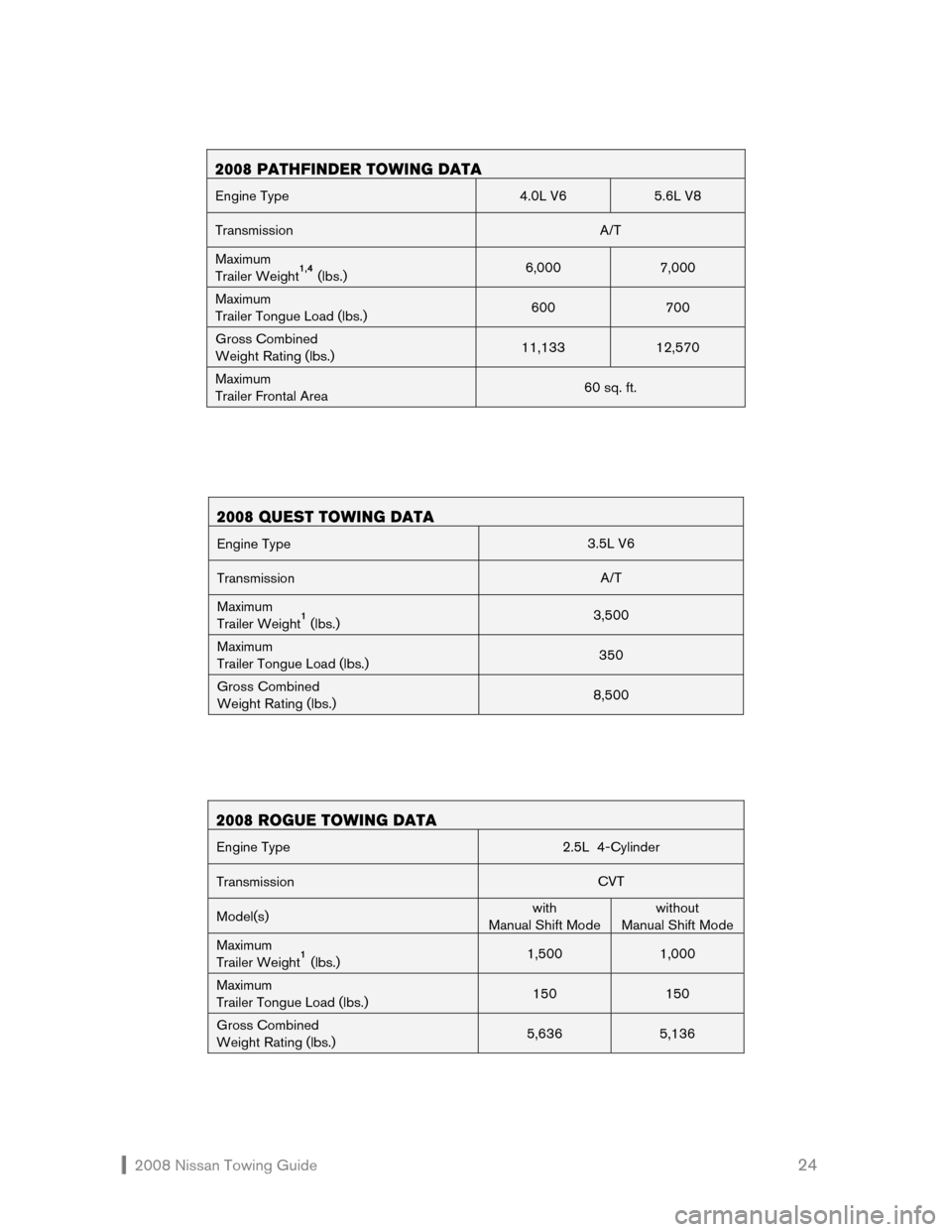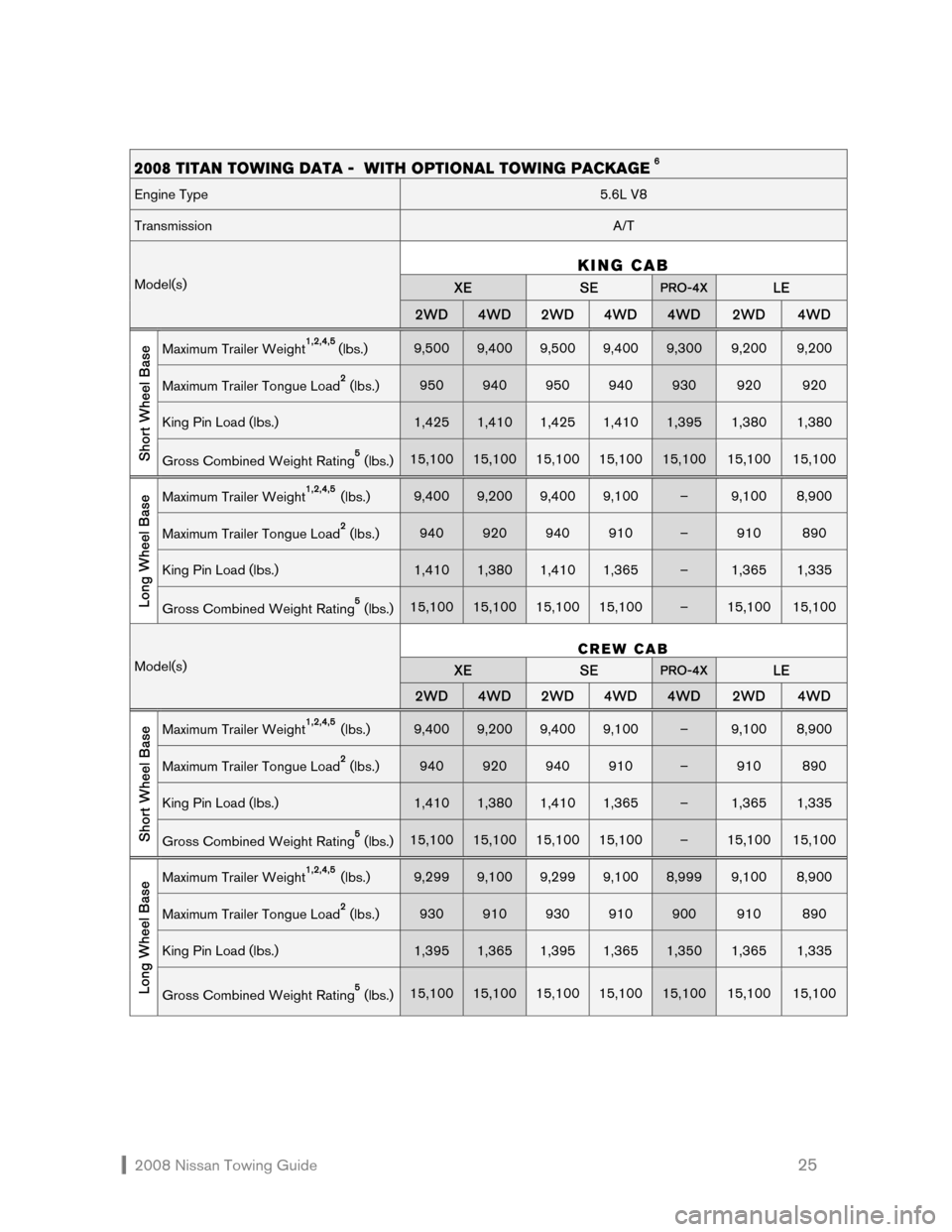2008 NISSAN MAXIMA trailer
[x] Cancel search: trailerPage 19 of 32

2008 Nissan Towing Guide 18 REDUCE SPEED
Drive your vehicle at a moderate speed, and remember to reduce your speed in unsafe or
less-than-ideal road conditions or weather. The tendency for a trailer to sway increases with
speed, and such swaying can result in a loss of control.
BRAKE SOONER
The combination of your tow vehicle and trailer obviously requires a greater distance to stop.
A good rule of thumb to remember is that for each 10 mph of speed, allow yourself one tow
vehicle and trailer length of distance between the front of your vehicle and the vehicle ahead.
When braking, use firm but gradual pressure on the pedal rather than panic braking.
Applying the brakes abruptly or with too much force can cause the trailer to skid or jackknife
at its point of attachment with the vehicle. This, in turn, can throw the tow vehicle out of
control. If equipped with an electric trailer brake controller, follow the recommended
operational instructions.
PASS CAREFULLY
As mentioned in the introduction to this section, because of the added weight of the trailer,
acceleration capability is reduced and you’ll require a longer distance to pass another vehicle.
Be certain you have sufficient time and space to pass safely. Obviously, never attempt passing
on hills or when going around curves.
CORNER MORE SLOWLY
Know your vehicle and trailer capabilities. Entering a sharp corner too quickly or abruptly can
“crack the whip,” whereby the trailer can actually pull the tow vehicle off the road. Therefore,
when approaching a relatively sharp corner, begin braking sooner than you would when not
towing. Do your braking in a straight line prior to the corner, and turn smoothly into it. In
addition, remember to make a wider turn than normal to ensure that the trailer safely clears the
inside of the turn.
When towing a 5th wheel or gooseneck trailer, do not make sharp turns while driving or
backing as the trailer may contact the vehicle and cause damage to both the trailer and
vehicle. A special extended 5th wheel pin box or sliding hitch may be required to provide
additional trailer-to-truck clearance for tight maneuvering.
BACK UP WITH CAUTION
Backing up with a trailer is a difficult maneuver; however, there is a “trick” that can simplify the
procedure considerably. Simply steer with one hand at the bottom of the steering wheel. To
turn the trailer to the left, first move the steering wheel to the left. To turn the trailer to the right,
Page 20 of 32

2008 Nissan Towing Guide 19 move the wheel to the right. All movements of the wheel should be done in small increments.
Of course, backing up should be done only at very slow speeds. For large trailers that
obstruct your rearward vision, have someone outside the vehicle act as a “spotter” to guide
you along.
PARK SMART
A tow vehicle and trailer can be an unwieldy combination in a small area, so always try to park
where you will have a relatively easy time maneuvering. Once parked, always block the wheels
on both the tow vehicle and the trailer.
Parking on a slope is not recommended. If, however, you must park on a slope and your
vehicle is equipped with an automatic transmission, there are some precautions you should
take:
�Š Have someone block the wheels once the tow vehicle and trailer are in position and being
held by the vehicle’s brake.
�Š Next, apply the parking brake and only then move the gear lever into PARK. If you move the
lever into PARK before blocking the wheels and applying the parking brake, transmission
damage may occur.
HIGH-ALTITUDE PERFORMANCE
An engine will lose about 4% of its performance for every 1,000 feet above sea level that you
travel. If you will be towing in high altitudes, it is a good idea to allow more time than usual due
to the engine’s reduced performance.
TOW MODE (IF EQUIPPED)
Tow Mode should be used when the vehicle and trailer weight is at least 75% of the vehicle
GCWR. This mode is most useful when towing a heavy trailer or hauling a heavy load,
particularly when stop-and-go traffic, rolling terrain, or a busy parking lot is involved.
Driving the vehicle in Tow Mode with minimal trailer load will not cause any damage;
however, fuel economy may be reduced and transmission/engine driving characteristics may
feel different.
HILLS – UPGRADES
As the incline increases, shift down to a lower gear to maintain speed and prevent the engine
from lugging. However, for long and steep grades, do not stay in first gear when driving above
35 mph or in second gear above 58 mph. The added weight of a trailer places an increased
load on the engine and cooling system, so monitor your coolant temperature gauge and
Page 21 of 32

2008 Nissan Towing Guide 20 automatic transmission fluid temperature gauge (if equipped) very carefully. At the first sign of
overheating, pull to the side of the road. See IF YOUR ENGINE OVERHEATS later in this
section for more information.
HILLS – DOWNGRADES
While going downhill, the weight of the trailer pushing on the tow vehicle may decrease
overall stability. Therefore, to maintain adequate control, reduce your speed and shift to a
lower gear.
Avoid long or repeated use of the brakes when descending a hill, as this reduces their
effectiveness and could cause overheating. Shifting to a lower gear instead provides “engine
braking” and reduces the need to brake as frequently.
AUTOMATIC CRUISE CONTROL
Do not use cruise control while towing a trailer.
IF YOUR ENGINE OVERHEATS
A moderate increase in engine operating temperature is normal when towing a trailer. If,
however, the coolant temperature gauge reading is abnormally high, or if you are experiencing
a significant loss of power, or if you hear unusual engine noises,* the engine may be
overheating and you should immediately take the following steps:
1. Pull your vehicle safely over to the side of the road, out of traffic. Apply the parking brake
and move the gearshift lever to NEUTRAL (manual) or PARK (automatic). DO NOT STOP
THE ENGINE.
2. Turn off the air conditioning and, after opening all the windows, turn the heater on to
maximum hot and the fan to its highest speed. The heater core in your vehicle is just like a
miniature engine radiator and will provide an extra cooling surface to help reduce engine
temperature.
3. Run the engine at a fast idle (approximately 1,500 rpm) until the temperature gauge returns
to a normal reading. If the temperature does not drop or continues to increase, stop this
step immediately.
4. Being cautious of traffic, step out of the vehicle and, from a safe distance, look for steam
underneath the engine. If you see steam or leaking coolant, stand clear to avoid being
burned and shut off your engine immediately and allow it to cool. If there is no steam, open
the hood. Never remove the radiator cap when the radiator is hot. If the cap is removed
under these conditions, hot water under high pressure may spurt out, possibly causing
*See your vehicle owner’s manual for additional indications that your vehicle may be overheating.
Page 22 of 32

2008 Nissan Towing Guide 21 serious injury.
5. As soon as the engine has cooled to its normal operating temperature, visually inspect
the drive belts for damage or looseness. A loose belt reduces water pump efficiency. Be
careful to keep your hands, hair, jewelry, and clothing clear of the running drive belt and
other moving parts when inspecting the engine and radiator. Also check to see if the
cooling fan is running, and inspect the water pump, radiator, and radiator hoses for leaks.
Keep in mind, too, that if your vehicle is equipped with an electric fan motor, it may start
without warning any time the coolant temperature is high. If you find leaking coolant, a
loose or missing drive belt, or an inoperable fan, turn off the engine immediately.
6. If no leaks are apparent and all other components appear to be operating properly with
the engine cooled to its normal operating temperature, check the coolant level in the
reservoir tank with the engine running. Add coolant to the reservoir tank if needed. At this
point, if repairs are required, go to the nearest Nissan dealer. See the IN CASE OF
EMERGENCY section of your vehicle owner’s manual for additional information on
overheating.
NOTE – Armada, Frontier, Pathfinder, and Titan vehicles have an engine protection mode,
which helps reduce the chance of engine damage if the engine coolant reaches a specified
temperature. See your vehicle owner’s manual for details.
TOWING
GLOSSARY
5TH WHEEL
HITCH Located just forward of the rear axle centerline, this hitch uses a
king pin to serve as the pivot point for the trailer.
BALL MOUNT A bar that holds the hitch ball and is inserted into the hitch receiver.
Also commonly called a drawbar or “stinger.”
BREAKAWAY SWITCH A safety device using a trailer battery that automatically applies the
trailer’s brakes if it should accidentally become separated from the
tow vehicle. A breakaway switch may be used with both electric or
surge trailer brake systems.
BUMPER HITCH A reinforced bumper designed to accommodate a hitch ball.
ELECTRIC TRAILER
BRAKES When the brakes on a tow vehicle are applied, an electric current is
sent to an actuator which applies the trailer’s brakes.
ELECTRIC TRAILER
BRAKE CONTROLLER A device that controls the electric trailer brakes.
Page 23 of 32

2008 Nissan Towing Guide 22
GOOSENECK HITCH Located just forward of the rear axle centerline, this hitch uses a
ball to serve as the pivot point for the trailer.
GROSS AXLE
WEIGHT RATING (GAWR)
The maximum amount of weight each vehicle axle (front and rear) is
designed to safely carry.
GROSS COMBINED
WEIGHT RATING (GCWR) The maximum allowable combined weight of the vehicle and trailer,
including passengers and all cargo.
GROSS VEHICLE
WEIGHT RATING (GVWR) The maximum allowable weight of the vehicle, including
passengers, cargo, fuel, hitch, trailer tongue load, and any optional
equipment.
KING PIN
LOAD The amount of trailer (5th wheel or gooseneck) weight pressing
down on the tow vehicle hitch.
HITCH BALL
A ball that connects the trailer to the tow vehicle hitch and provides
the means by which the trailer pivots during cornering. Available in
a number of sizes and weight capacities, it must correspond to the
trailer coupler size, and have a sufficient capacity rating for the
trailer being pulled.
RECEIVER HITCH A frame- or structure-mounted hitch with a receiver that allows
removal of the ball mount.
SAFETY CHAINS/CABLES Provides an emergency connection between the tow vehicle and
the trailer, should the trailer become disengaged for any reason.
SURGE BRAKES
Hydraulic-type braking system activated by inertia. As the tow
vehicle begins to brake, the trailer pushes against the hitch ball,
consequently activating the trailer brakes.
TRAILER TONGUE/COUPLER The part of the trailer that extends forward to meet the tow vehicle,
and also carries the coupler assembly.
TRAILER TONGUE
LOAD The amount of trailer (conventional) weight pressing down on the
tow vehicle hitch.
WEIGHT-DISTRIBUTING
HITCH SYSTEM Type of hitch system that helps shift the trailer tongue weight to all
trailer tires and the tow vehicle front tires. Strongly recommended
when towing trailers with a Maximum Trailer Weight greater than
5,000 lbs.
WIRING HARNESS
Provides an electrical connection linking the tow vehicle’s electrical
system to the trailer’s system.
Page 24 of 32

2008 Nissan Towing Guide 23
SPECIFICATIONS
TOWING CAPACITIES
SUV’s, Trucks, and Minivan
2008 ARMADA TOWING DATA
Engine Type 5.6L V8
Transmission A/T
Model(s) 2WD 4WD
without optional tow package 6,500 6,500 Maximum
Trailer Weight1,4 (lbs.) with optional tow package6 9,100 9,000
without optional tow package 650 650 Maximum
Trailer Tongue Load (lbs.) with optional tow package6 910 900
without optional tow package 12,800 13,000 Gross Combined
Weight Rating (lbs.) with optional tow package6 15,100 15,100
2008 FRONTIER TOWING DATA
Engine Type 2.5L
4-Cylinder 4.0L V6
Transmission A/T & M/T
Model(s)
King
Cab
2WD
King
Cab
2WD
King
Cab
4WD
Crew
Cab
2WD
Crew
Cab
4WD
Maximum
Trailer Weight1,3,4 (lbs.) 3,500 6,500 6,300 6,300 6,100
Maximum
Trailer Tongue Load3 (lbs.) 350 650 630 630 610
Gross Combined
Weight Rating (lbs.) 7,936 11,133 11,133 11,133 11,133
Maximum
Trailer Frontal Area 60 sq. ft.
Page 25 of 32

2008 Nissan Towing Guide 24
2008 PATHFINDER TOWING DATA
Engine Type 4.0L V6 5.6L V8
Transmission A/T
Maximum
Trailer Weight1,4 (lbs.) 6,000 7,000
Maximum
Trailer Tongue Load (lbs.) 600 700
Gross Combined
Weight Rating (lbs.) 11,133 12,570
Maximum
Trailer Frontal Area 60 sq. ft.
2008 QUEST TOWING DATA
Engine Type 3.5L V6
Transmission A/T
Maximum
Trailer Weight1 (lbs.) 3,500
Maximum
Trailer Tongue Load (lbs.) 350
Gross Combined
Weight Rating (lbs.) 8,500
2008 ROGUE TOWING DATA
Engine Type 2.5L 4-Cylinder
Transmission CVT
Model(s) with
Manual Shift Mode
without
Manual Shift Mode
Maximum
Trailer Weight1 (lbs.) 1,500 1,000
Maximum
Trailer Tongue Load (lbs.) 150 150
Gross Combined
Weight Rating (lbs.) 5,636 5,136
Page 26 of 32

2008 Nissan Towing Guide 25
2008 TITAN TOWING DATA - WITH OPTIONAL TOWING PACKAGE 6
Engine Type 5.6L V8
Transmission A/T
KING CAB
XE SE PRO-4X LE Model(s)
2WD 4WD 2WD 4WD 4WD 2WD 4WD
Maximum Trailer Weight1,2,4,5 (lbs.) 9,500 9,400 9,500 9,400 9,300 9,200 9,200
Maximum Trailer Tongue Load2 (lbs.) 950 940 950 940 930 920 920
King Pin Load (lbs.) 1,425 1,410 1,425 1,410 1,395 1,380 1,380
Short Wheel Base Gross Combined Weight Rating5 (lbs.)15,10015,10015,10015,10015,100 15,100 15,100
Maximum Trailer Weight1,2,4,5 (lbs.) 9,400 9,200 9,400 9,100 – 9,100 8,900
Maximum Trailer Tongue Load2 (lbs.) 940 920 940 910 – 910 890
King Pin Load (lbs.) 1,410 1,380 1,410 1,365 – 1,365 1,335
Long Wheel Base Gross Combined Weight Rating5 (lbs.)15,10015,10015,10015,100– 15,100 15,100
CREW CAB
XE SE PRO-4X LE Model(s)
2WD 4WD 2WD 4WD 4WD 2WD 4WD
Maximum Trailer Weight1,2,4,5 (lbs.) 9,400 9,200 9,400 9,100 – 9,100 8,900
Maximum Trailer Tongue Load2 (lbs.) 940 920 940 910 – 910 890
King Pin Load (lbs.) 1,410 1,380 1,410 1,365 – 1,365 1,335
Short Wheel Base Gross Combined Weight Rating5 (lbs.)15,10015,10015,10015,100– 15,100 15,100
Maximum Trailer Weight1,2,4,5 (lbs.) 9,299 9,100 9,299 9,100 8,999 9,100 8,900
Maximum Trailer Tongue Load2 (lbs.) 930 910 930 910 900 910 890
King Pin Load (lbs.) 1,395 1,365 1,395 1,365 1,350 1,365 1,335
Long Wheel Base Gross Combined Weight Rating5 (lbs.)15,10015,10015,10015,10015,100 15,100 15,100